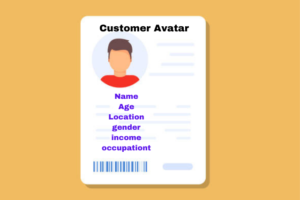A buyer persona, Marketing persona, Customer avatar, or target market are not new phrases in the marketing industry.
The above phrases are sometimes used interchangeably when describing a fictional, generalized representation of a buyer persona that is most likely to buy from you.
Having an ideal customer avatar would give you a deeper understanding of who your customers are.
It makes your marketing strategy more efficient by delivering the right type of content to your target audience.
What is a Customer Avatar

A customer avatar is essentially a profile of the perfect customer or client that is likely to buy your product or services.
Understanding your ideal customer, their habits, interests, challenges, etc. would make your marketing strategy more effective when marketing to them.
Without an ideal customer avatar, it becomes incredibly difficult to market to your audience.
Therefore you end up marketing to random people who might not even be interested in what you are selling.
Benefits of Having a Customer Avatar
Having an ideal customer persona can help you in the following ways
- It can help you determine which social platforms your customers are spending time on so you know where your business should be present and active
- Run more targeted and effective ads; your money will be well spent when you know where to advertise and who to target for maximum exposure.
- Write copy that connects with your marketing avatar, which will give you a better understanding of their pain points, goals, and successes
- It helps you deliver better quality services to your customers because you are able to anticipate their needs beforehand.
Types of Avatars
Multiple avatars
Having multiple avatars is when you have more than one ideal customer, especially when offering more than one product or service.
Create an avatar for each of the products or services or create avatars that target some ideal customers in your industry
The best way to define your customer avatars is to tackle them one at a time.
You can start with the market that brings the most profit to your business.
Negative avatars
A negative avatar is a generalized representation of the persona that you don’t want as a customer.
Having an understanding of who you don’t want to serve as a customer would make it easier to know who you do want to serve.
for example, you are selling an iPhone and you are creating an avatar of people between the age 60 and above.
The key here is to not focus on personal characteristics of why the individual was not easy to work with, but rather on the reasons why they weren’t a good fit for your product or service.
For example, high prices, not being properly equipped, etc.
How To Create A Customer Avatar
1. Name your avatar
In creating an ideal customer avatar, the first thing for you to do is to name your avatar.
Naming your avatar gives your profile a professional look and makes it look more human.
If you are targeting a male audience you can create a male name and if it’s a female, you can as well give it a female name.
In a scenario where you are targeting both men and women, you’ll want to create a male and female name.
2. Make use of Images
Find a free picture online from sites like Pixarbay, freepik, etc. that best represents what your avatar looks like visually.
3. Design a Dossier
A dossier refers to a one-page document that has information about your avatar that includes its name, picture, information, and story.
This gives your avatar a more professional look.
4. Use a Story

Assume the personality of your avatar and write a story journaling about the discovery of your product or service.
What were they thinking before they bought your product?
How were they feeling? Why were they feeling that way? What were they looking for?
What were they hoping to solve or accomplish? How did they find you or hear about you?
How did they feel once they purchased your product or service?
5. Start with their Demographic traits
List out your avatar’s demographic traits ranging from their age, sex, education level, income level, location, marital status, occupation, religion, and average family size, etc.
List them out and start defining them one after the other.
6. Determine their Psychographic traits
These are a little more complicated and require a deeper understanding of your client’s avatar.
These are based on values, attitudes, interests, and lifestyle, motivations, challenges, etc.
It might be what your customer does for fun, challenges your customer might face, what motivates them to take some certain action,
Examples include: wanting a healthy lifestyle, valuing time with family, loves clubbing, playing football, not knowing how to run google Ads, not knowing how to use WordPress and the list goes on.
Do your research well on your customers to be able to determine some of these traits.
